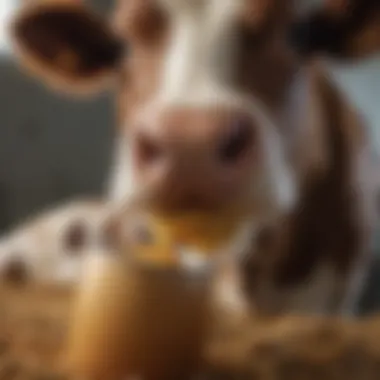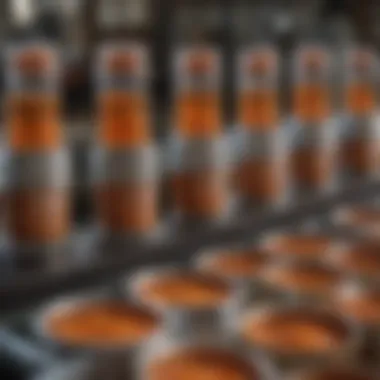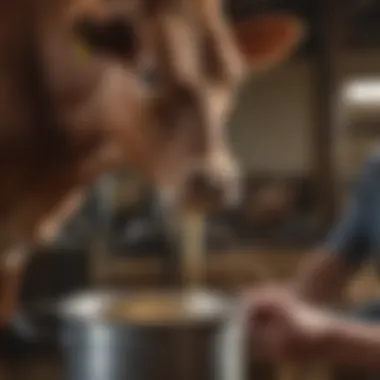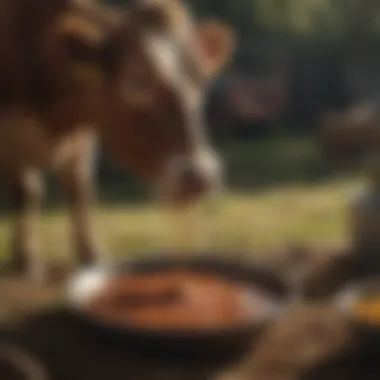Exploring the Importance of Cow Teat Dippers


Intro
The dairy industry relies heavily on efficient milking practices and maintaining animal health. Cow teat dippers play a critical role in achieving these objectives. Understanding the features of this essential equipment can drastically enhance milking operations, ensuring both animal welfare and high-quality milk production.
This article will look at key concepts and terminology surrounding cow teat dippers. We will explore various innovations and trends shaping the industry. Additionally, we will discuss practical applications and techniques that can improve the use and effectiveness of cow teat dippers. By the end of the article, readers will have a comprehensive understanding of this important tool in dairy farming.
Preamble to Cow Teat Dippers
The global dairy industry relies heavily on the effective management of udder health, milking efficiency, and hygiene. In this context, cow teat dippers play an essential role. These devices are designed to enhance the milking process while ensuring the well-being of dairy cows. Understanding their purpose, types, and implications in dairy farming is crucial for anyone involved in this sector.
Definition and Purpose
Cow teat dippers are tools used to apply an antiseptic solution to the teats of dairy cows. This is done before and after milking to minimize the risk of infections and maintain udder health. The primary function of these dippers is to create a barrier against harmful pathogens that can affect both the cows and the quality of the milk produced. By ensuring that teats are sanitized, dippers not only protect the animal but also contribute to improving the overall quality and safety of dairy products.
Importance in Dairy Farming
The importance of cow teat dippers cannot be overstated. They serve several vital functions:
- Infection Control: Teat dippers significantly reduce the incidence of mastitis, a common and costly infection in dairy cows.
- Milk Quality: By maintaining acceptable hygiene standards, dippers help ensure that the milk collected is free from contaminants.
- Milking Efficiency: Using teat dippers reduces the time needed for cleaning and preparation, leading to more efficient milking operations.
- Animal Welfare: The use of proper hygiene practices fosters better overall health for cows, which can enhance their productivity and lifespan.
"The role of cow teat dippers extends beyond simple hygiene; they are a pivotal element in enhancing the welfare of dairy cows and the efficiency of dairy farms."
By grasping the fundamental aspects of cow teat dippers, farmers and dairy professionals can implement better practices that not only benefit their operations but also align with the increasing demand for high-quality dairy products on the market.
Types of Cow Teat Dippers
The exploration of cow teat dippers benefits significantly from understanding the different types available in the market. Each type of dipper offers unique functionalities and advantages, catering to the diverse needs of dairy farming. This section provides clarity on manual versus automated dippers, the choice between single-use and reusable options, and the variations in design across brands. Such knowledge is invaluable for optimizing milking efficiency and ensuring cow health.
Manual vs. Automated Dippers
Manual cow teat dippers have been traditionally used in dairy farms for many years. These dippers require human intervention, allowing farmers to have more control over the cleaning process. Manual dippers often come in various designs, enabling farmers to choose based on their convenience and cost. However, the labor-intensive nature can be time-consuming and physically demanding.
On the other hand, automated dippers introduce technology to the milking process. They are designed to minimize human effort and speed up the cleaning tasks. Automated dippers often feature sensors and software that ensure accurate application of sanitizing solutions. This not only saves time but also maintains consistency in application. Moreover, automated systems can reduce cross-contamination risk, enhancing overall hygiene.
Single Use vs. Reusable Dippers
The choice between single-use and reusable cow teat dippers becomes crucial in managing costs and environmental impact. Single-use dippers are typically made from lightweight materials. They can be discarded after one usage, which eliminates concerns about contamination between different milking sessions. However, this option can be costly in the long run and contributes to waste.
Conversely, reusable dippers are designed for multiple uses. They can be washed and sterilized between milking sessions, thus promoting sustainability. Farmers must keep proper maintenance practices to ensure they do not compromise hygiene. Reusable dippers, if well-maintained, can provide a cost-effective solution and support the idea of reducing plastic waste.
Design Variations Across Brands
Design variations in cow teat dippers are prevalent across various brands, and understanding these differences could inform purchase decisions. Some brands prioritize ergonomics, providing dippers that fit comfortably in hand for prolonged use. Others focus on efficacy, using unique shapes or materials that optimize sanitization processes.
The level of customization offered by brands also affects choices. Some manufacturers allow for personalized features, such as color-coded dippers for different barns or sectors of the farm. Another significant factor is the ease of cleaning – some dippers can be disassembled for thorough sanitation, while others may have a more complex design that complicates this process.
Overall, selecting the right type of cow teat dipper is vital to achieving the desired balance of efficiency, cost-effectiveness, and animal welfare. Varying factors like brand design, functionality, and intended use must be considered carefully by dairy farmers.


Materials Used in Cow Teat Dippers
The materials used in the construction of cow teat dippers are of paramount importance. These materials not only influence the effectiveness of the product but also correlate directly with the overall health of the dairy cows. Farmers must consider multiple factors including hygiene, durability, and cost when selecting a suitable cow teat dipper. The right material can significantly impact the maintenance of udder health, the milking process, and environmental concerns.
Types of Materials
Cow teat dippers are commonly made from various materials, each offering distinct advantages and disadvantages.
- Plastic: This is one of the most frequently used materials due to its lightweight and affordable nature. Plastic dippers are often easy to handle and can be produced in various designs; however, their longevity is sometimes questioned.
- Metal: Stainless steel provides a robust option. Metal dippers are more durable and resistant to wear and tear. They are also easier to clean, an essential factor for maintaining hygiene in dairy farming.
- Silicone: This material has emerged as a viable option as it is flexible and gentle on the cow's udder while still being durable. Its non-porous surface also minimizes the risk of bacterial growth.
Each material type has its place depending on specific needs and conditions within the dairy environment.
Impact on Biodegradability and Health
The choice of materials also has an impact on biodegradability and cow health. In recent years, there has been a growing awareness of environmental sustainability. Farmers face pressure to select products that are less harmful to the environment.
- Biodegradable Options: Some manufacturers now produce teat dippers from biodegradable materials. These options break down more easily in landfills and have less impact on ecosystems.
- Health Risks: Certain materials, if not properly manufactured, can leach harmful chemicals. Plastic variants may require specific attention due to potential health risks associated with long-term use. Farmers must ensure that the materials used are safe and approved for animal contact to avoid any adverse effects on udder health.
Durability and Cost Factors
Durability directly influences long-term costs in the dairy farming industry. Investing in quality materials may come at a higher upfront cost but can lead to savings over time.
- Initial Cost: Plastic dippers are generally cheaper but may need frequent replacements. In contrast, metal or silicone dippers, while more expensive initially, tend to last longer and withstand the rigors of daily use.
- Maintenance Costs: The ongoing costs for cleaning and maintenance should also be factored in. Stainless steel dippers may incur higher cleaning costs initially due to their sturdiness but ultimately save farmers from needing replacement dippers.
Best Practices for Cow Teat Dipper Use
The use of cow teat dippers is essential in dairy farming. Following best practices ensures not only the health of the cows but also increases the efficiency of milking. By understanding and implementing these practices, farmers can improve both productivity and animal welfare. This section will discuss the importance of following specific procedures before and after milking, as well as highlights the need for regular hygiene and maintenance of equipment.
Pre-Milking Procedures
Pre-milking procedures are crucial for the overall health of the cow and the quality of the milk produced. Each step in this process serves a purpose. Prior to applying the teat dip, it is essential to wash the udder thoroughly. This removes any dirt or contaminants that can enter the milk during milking. Use warm water and a mild soap to wash the teats. Avoid using harsh chemicals that may irritate the skin.
Once the udder is clean, ensure that the environment is as hygienic as possible. Clean pens and milking areas help minimize bacteria exposure. After washing, apply the teat dip. The dip should be formulated to prevent infection and provide a protective barrier. Selecting a dip with appropriate active ingredients is essential. Each farmer should also be aware of the manufacturer's guidelines for application.
"Effective pre-milking practices can significantly enhance milk quality and udder health."
Post-Milking Care
After milking, the focus shifts to maintaining udder health and preventing mastitis. Teat dipping should also take place post-milking. The purpose of post-milking dip is to provide added protection to the teats. Immediate application after milking helps seal off the openings. Cow teats are vulnerable after milking due to expanded orifices, and this period is crucial for preventing pathogens from entering.
In addition to dipping, monitoring the cows for any irritations or signs of infection is necessary. Regularly inspecting the teats can lead to early detection of issues. Providing a clean and dry environment post-milking is equally important. Avoid allowing cows to stand in wet or muddy areas after milking, as this increases the risk of infections.
Hygiene and Maintenance
Regular hygiene and maintenance of cow teat dippers play a significant role in their effectiveness. All teat dip containers should be kept clean and properly sealed. Ensure that your dipping equipment undergoes regular inspections to identify signs of wear or damage. Any observed issues should be addressed immediately.
The dipping solution should be stored in a cool, dry environment to prevent degradation. Farmers should also replace any expired products. It is a good practice to keep detailed records of when products are used and their batch numbers. This can be especially helpful in managing health concerns and ensuring quality.
In summary, adopting best practices for cow teat dipper use requires dedication and awareness. By paying attention to pre-milking procedures, post-milking care, and hygiene and maintenance, farmers can enhance the overall health of their herd and the quality of the milk produced.


Challenges Faced in Cow Teat Dipper Usage
Addressing the challenges in cow teat dipper usage is crucial for maintaining both animal welfare and farm efficiency. Understanding these challenges helps farmers and dairy practitioners optimize milking practices. This section explores common problems and offers solutions to improve the effectiveness and reliability of cow teat dippers. The aim is to equip readers with practical insights to overcome obstacles that may hinder optimal performance in dairy operations.
Common Problems Encountered
Several problems can arise during the use of cow teat dippers. These issues can affect not only the quality of milking but also udder health and farm productivity. Common problems include:
- Inconsistent Application: Dippers may fail to uniformly apply disinfectants or pre-milking solutions, risking uneven coverage on cow teats.
- Material Wear and Tear: Frequent use may lead to the degradation of dipper components, affecting their performance over time.
- Bacterial Growth: Improper cleaning or storage can lead to bacterial buildup in dippers, which is harmful to udder health.
- User Error: Misuse or misunderstanding of the dipper’s mechanism can lead to inefficient operation.
- Cost Constraints: High-quality or automated dippers may present financial challenges, leading to the use of subpar equipment.
These issues create a need for awareness and education surrounding best practices in dipper usage.
Solutions and Remedies
Given the challenges identified, implementing effective solutions can greatly enhance the milk production process. Farmers can adopt several strategies:
- Regular Training: Providing ongoing training for farm staff ensures that everyone understands how to operate dipper systems correctly. This reduces user error and improves efficiency.
- Routine Maintenance: Schedule regular checks on dipper equipment to catch wear and tear before it leads to failure. Replace worn parts promptly to maintain performance.
- Effective Cleaning Protocols: Establishing a strict cleaning regimen helps prevent bacterial growth in dippers. This includes thorough rinsing and storage in clean, dry conditions.
- Investing in Quality Equipment: While cost is a factor, choosing durable, high-quality products can be more economical in the long run. Brands like DeLaval and GEA offer innovative designs that improve usability.
- Monitoring Application Consistency: Utilize dipper models with built-in features to ensure consistent application of solutions. Adopting technology that tracks usage and performance can also help monitor efficiency.
Addressing these common problems proactively can lead to significant improvements in milk quality and overall dairy farm operations.
The Role of Cow Teat Dippers in Animal Welfare
Cow teat dippers play a crucial role in promoting animal welfare in dairy farming. Their design and usage directly impact the health of the cows, which is vital for productive and sustainable dairy operations. Proper management and utilization of these tools can enhance the overall well-being of the cows, ensuring they remain healthy and productive throughout their milking periods.
Impact on Udder Health
When considering cow teat dippers, udder health is a primary concern. A clean and well-maintained udder is essential not only for milk quality but also for the general health of the cow. The use of effective teat dips reduces the risk of mastitis, a common condition that can lead to high veterinary costs and reduced milk yield.
By applying a suitable teat dip prior to milking, farmers can displace pathogens and avoid contamination. Regular cleaning and sanitation protocols can be integrated with the use of both manual and automated dippers. Specific products should be chosen based on their efficacy in reducing udder infections. Adopting strict hygiene practices will be beneficial not just for the individual cows but for herd health as a whole.
Reducing Stress and Enhancing Comfort
Stress in dairy cows can lead to decreased milk production and overall poor health. Cow teat dippers, when used correctly, can help in minimizing stress during the milking process. Cows are sensitive animals, and exposure to unpleasant experiences can create anxiety. A gentle, efficient milking process supported by appropriate dipper technology can enhance comfort and reduce the likelihood of stress-related issues.
Making the milking environment calm and predictable is essential. Providing a stress-free experience allows cows to maintain a relaxed posture, leading to better milk flow and quality. Additionally, utilizing single-use products can eliminate potential irritants that contribute to discomfort. Implementing these measures ultimately results in higher milk yield and better overall cow welfare.
"The health of a cow directly translates to the performance of a dairy operation. Investing in proper teat dippers is not merely about hygiene; it’s about ensuring animal welfare and sustainability in dairy farming."
Environmental Considerations
The role of cow teat dippers extends beyond milking efficiency and animal welfare. A critical aspect that is gaining traction in the dairy industry is the environmental impact of their use and production. As society becomes increasingly aware of sustainability issues, understanding how these tools affect the environment is essential. This section will explore various factors connected to the environmental consequences of cow teat dippers, focusing on sustainable practices and waste management.
Sustainability in Dipper Production
Sustainable production of cow teat dippers is an important consideration for the dairy sector. The materials used in manufacturing these dippers significantly determine their environmental footprint. For instance, farmers now prefer dippers made from biodegradable or recyclable materials. The trend toward using renewable resources helps reduce reliance on fossil fuels and lowers carbon emissions throughout the production cycle.
When brands prioritize sustainability, they tend to incorporate practices such as:


- Using recycled materials: This reduces waste and lowers demand for virgin resources.
- Energy-efficient processing: Manufacturers are working on reducing energy consumption during the production process.
- Designing for longevity: By creating robust products, companies limit the need for frequent replacements, thus having a positive effect on the environment.
Implementing these practices can make a significant difference not only for the ecosystem but also for the image of a dairy operation. Producers who embrace sustainability can attract a more conscious consumer base.
Waste Management and Recycling
Effective waste management strategies for cow teat dippers are crucial in minimizing environmental impacts. As the dairy industry grows, managing waste from both single-use and reusable dippers comes under scrutiny. Special attention is needed to ensure responsible disposal methods are in place.
Some actions that can help enhance waste management include:
- Proper disposal of single-use dippers: Implement programs that encourage recycling where possible, to reduce landfill contributions.
- Collection programs for used dippers: Engaging in initiatives to gather used dippers can facilitate recycling efforts, ensuring materials are processed efficiently.
- Design improvements: Innovating products that can biodegrade naturally contributes to waste reduction.
By focusing on waste management and recycling, farmers can contribute to a cleaner environment, aligning with global sustainability goals.
The focus on environmental considerations is more than just a trend; it is becoming a fundamental part of operational strategies in the dairy industry. Producers are called to be proactive in finding ways to integrate sustainability into every aspect of their processes. The future of dairy farming relies on balancing productivity with ecological responsibility.
Future Innovations in Cow Teat Dipper Technology
The dairy industry is evolving, and this evolution influences the development of essential tools like cow teat dippers. Innovations in this area are not merely beneficial but necessary for improving efficiency, maintaining hygiene, and ensuring animal welfare. Owners of dairy farms are increasingly looking for technologies that can enhance their operations by decreasing labor costs and optimizing health outcomes for their cows. The relevance of future innovations in cow teat dipper technology is evident in these aspects.
Technological Advancements
New technologies in cow teat dipper production focus on automated systems that improve efficiency. These automated systems can offer precision in application, ensuring the right amount of disinfectant is used. Such advancements reduce the manual labor required, allowing farmers to allocate their workforce more efficiently.
Moreover, the integration of smart technologies, like sensors, is becoming more common. These sensors can monitor the health of the cows' udders in real-time. Farmers can receive updates on the condition of teat health, helping them to act proactively to any signs of infection or irritation. The fusion of these technologies with existing dipper systems creates a more sophisticated approach to milking that not only protects the cow's health but can also improve productivity.
In addition, manufacturers are experimenting with eco-friendly materials in the design of cow teat dippers. Such materials are not only durable but also biodegradable, which helps reduce long-term environmental impacts. Innovations in materials science can lead to dippers that are easier to clean, thus making them more hygienic and efficient.
Predicted Trends in Dairy Farming
As technology continues to advance, several trends are predicted to gain traction in dairy farming. One significant trend is the increased emphasis on sustainable farming practices. This means that dairy farms will likely adopt dippers that minimize waste and use materials that are environmentally friendly. Farmers are becoming aware of their environmental impact, and many are motivated to implement changes to reduce it.
Another trend is the move towards integrated systems that connect various aspects of farm management. For instance, cow teat dippers may be linked to a central system that tracks both milking and health data. This integration will allow farmers to analyze patterns, leading to better decision-making regarding herd management.
Lastly, training and education will increasingly focus on new technologies. Farmers will require up-to-date knowledge of how to use these innovations effectively. This need will prompt more training programs and workshops focusing on emerging technologies within the dairy sector.
Innovations in cow teat dipper technology will shape the future of dairy farming, marrying efficiency with sustainability and improved animal care.
Through these advancements and trends, the dairy industry is poised to become more efficient, healthier, and more sustainable. The successful adoption of new technologies will signify a significant shift in how dairy farmers manage their operations in the years to come.
Finale on the Importance of Cow Teat Dippers
In the context of modern dairy farming, cow teat dippers play a crucial role. Their importance extends beyond basic functionality; they significantly impact udder health, milking efficiency, and overall hygiene. These devices are essential for maintaining the health of dairy cattle, which directly correlates with the quality of milk produced. The right teat dipper can prevent infections and promote healing, ensuring the well-being of the herd. Farmers must recognize that investment in quality teat dippers leads to long-term benefits, including reduced veterinary costs and improved milk yields.
Summary of Key Points
- Cow teat dippers are crucial for udder health.
- They help in preventing infections and promoting healing.
- Using proper dipper can enhance milking efficiency.
- There are various designs, materials, and best practices.
- Ongoing research is necessary for further advancements.
"Cow teat dippers form the backbone of a hygienic milking process, reflecting a blend of tradition and innovation in dairy farming."
Call for Continued Research and Development
The landscape of dairy farming is constantly evolving. There is a pressing need for continued research and development in the field of cow teat dippers. It is important to explore new materials that enhance hygiene and biodegradability while considering the economic aspects.
Investment in this area will not only improve current products but also lead to innovations that cater to the ever-changing demands of the industry. Such advancements could include automated systems that ensure precise application, more effective formulations that enhance udder protection, and eco-friendly manufacturing processes. Farmers, agronomists, and researchers must collaborate to advance knowledge and technology surrounding cow teat dippers for the benefit of the industry.















